The mouthpiece is important in creating sound production. The tone can be changed in a variety of nuances just by using different types of mouthpieces.
What is a mouthpiece?
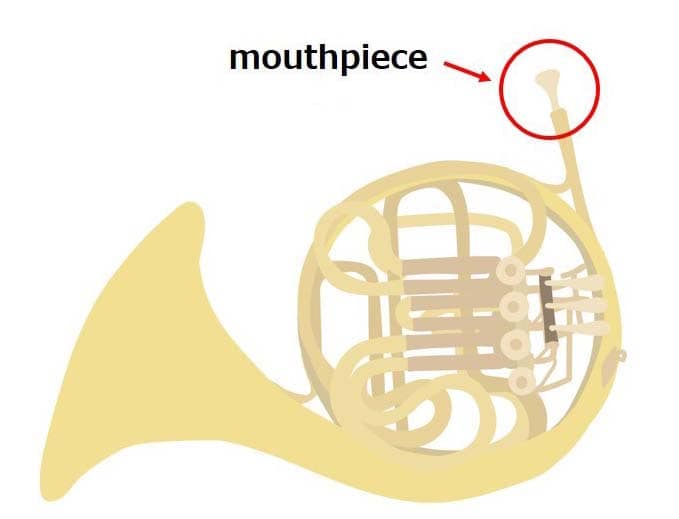
A mouthpiece is a separate piece that is attached to the horn. The opening is where the player’s lips are played. Vibrating the lips on the mouthpiece is what produces a sound.
Materials Used for the Mouthpiece
Generally, horn mouthpieces are made of brass with silver or gold plating.
Other mouthpieces are made of plastic or resins.
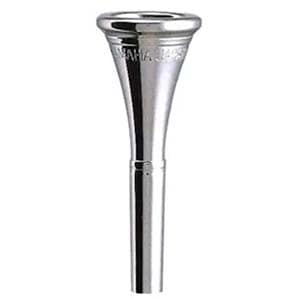
Brass plated with silver
Brass mouthpieces with silver plating are the most common. The sound is usually a little darker.
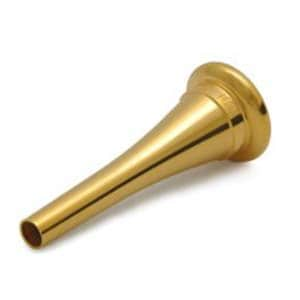
Brass plated with gold
Gold-plated mouthpieces feel very smooth on the lips. Although gold-plated may have a little more resistance than silver-plated mouthpieces, the smooth touch allows for more flexible lip control. These mouthpieces are made to be partially gold-plated and fully gold-plated.
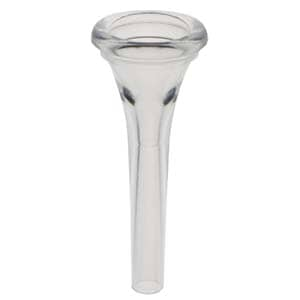
Plastic
Plastic (resin) is a lightweight and durable material. For use during practice, some mouthpieces are made in clear colors so the player can check his/her embouchure. They can be made in various colors and these mouthpieces are a great option for people who are worried about metal allergies.
How to Choose a Horn Mouthpiece
The most important thing to keep in mind when choosing a horn mouthpiece is to choose a mouthpiece with the right shank.
What is a shank?
A shank is the long tube that extends from the cup of the mouthpiece and is the part that is inserted into the instrument. The shank differs depending on the type of instrument, so the size must fit correctly into each instrument.
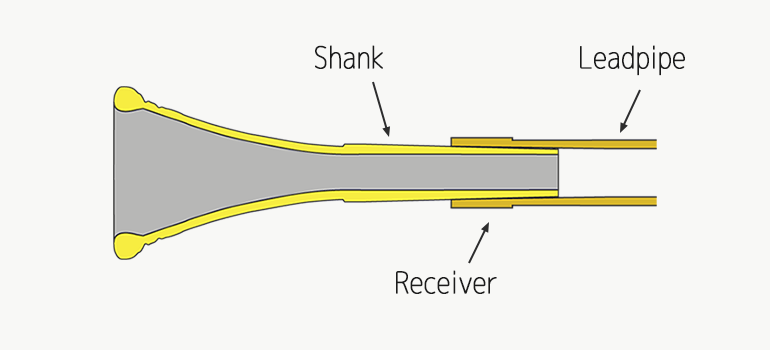
European Shanks and American Shanks
There are two types of shanks for horn mouthpieces: the European shank and the American shank.
The difference between these two types of mouthpieces can be seen in the taper of the shanks. The European shank has a less acute angle than the American shank.
If the shank doesn’t fit the leadpipe of the instrument, air will leak out or the mouthpiece will not sit stably.
| European Shank | American Shank | |
|---|---|---|
| Musical Instrument Manufacturers | Yamaha Alexander Schmid | Yamaha Holton Hans Hoyer Conn |
| Mouthpiece | Alexander Schmid Tilz Best Brass | Schilke JK (Josef Klier) Tilz Best Brass |
| Taper | 3/100 (For every 100mm in shank length, the diameter of the shank will be 3mm thinner) | 5/100 (For every 100mm in shank length, the diameter of the shank will be 5mm thinner) |
*Some manufacturers may have both types in their lineup.
*Yamaha horns have a double shank that fits both types.
Structure of the Horn Mouthpiece
In addition to the material and shank, the most important factor that determines tone and the feel of a mouthpiece is the internal structure. A very small difference can significantly change in tone and feel.
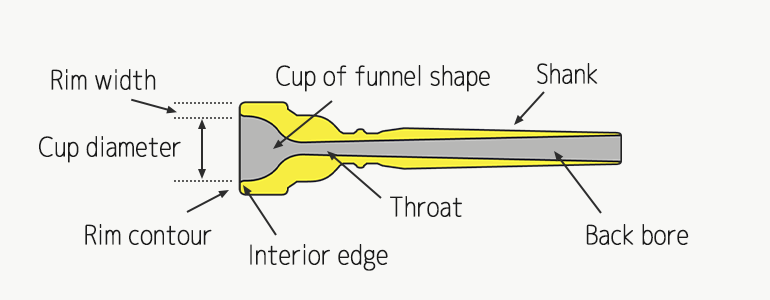 ※A trumpet mouthpiece.
※A trumpet mouthpiece.Cup Diameter
Depth of the Cup
| Shallow Cup | Deep Cup |
|---|---|
 |
 |
| Brighter tones and easier to produce high notes. Quieter volume. |
Darker tones and easier to produce lower notes. Louder volume. |
Shape of the Cup
There are two main types of cup shapes: ‘U shape’ and ‘V shape’.
| U-shaped | V-shaped |
|---|---|
 |
 |
| Bright tone and produces high notes | Dark tone and produces low notes |
On the French horn, there is also a “double cup” mouthpiece that combines the U and V-shaped that are designed for easier playing in the full range.
Rim Contour
The rim contour can drastically change the tone because it is where the player’s lips touch.
A thick or wide rim has a wide area for the lips that helps to make playing high notes easier for the player without becoming as tired. However, a wide rim also restricts the movement of the lips, which can make the lips lose flexibility.
A thinner and narrower rim offers more control and flexibility, but because there isn’t as much space for the lips, they can tire the player sooner from too much pressure.
Rim Bite
A rim bite mainly refers to the angle in the area from the rim to the cup. A mouthpiece with a sharp (steep) rim bite will give the player a precise, stable sound and a rich tone, but if the rim bite is too steep, it can interfere with lip flexibility and limit control.
On the other hand, a mouthpiece with a less edgy (round) rim bite sounds muffled at the beginning of the note and it’s difficult for the player to keep the pitch.
Throat
The throat is located in the bottom of the cup, where it connects to the shank. It is the narrowest part of the mouthpiece bore. It greatly affects the sense of resistance when playing. A long, thin throat produces a bright tone with strong resistance and a sense of speed, making it easier for the player to produce high notes. A thicker, shorter throat produces a darker tone and louder volume, but has less resistance and tends to tire the player’s lips out faster.
Back Bore
The back bore is the part at the end of the throat. Like the throat, the thickness of the back bore changes the tone and resistance.
| Narrow | Wide |
|---|---|
 |
 |
| Strong Resistance Bright tone with a sense of speed Easy to produce high notes |
Less resistance and less tiring Darker tone and louder volume |
Conclusion
In this article, we introduced a couple of mouthpieces that greatly affect the tone and the feel of the horn when playing. In addition to the structure of the mouthpiece, various other factors such as the player’s teeth alignment, the shape of the lips, and the muscles of the mouth affect the response and tone. Of course, it is also important to choose a mouthpiece that suits your instrument. Try out some different models and find the perfect mouthpiece for you.














